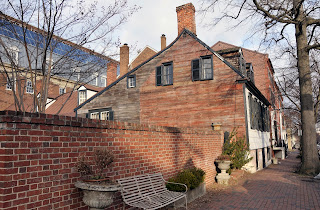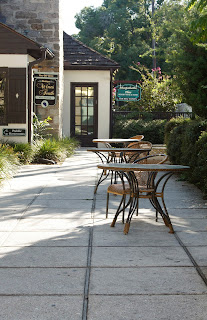This series is dedicated to Eugene Atget as one of the most important photographer and influence in my work as an artsist.
Capturing what attracts my attention with a hint of nature & lighting......
Friday, May 11, 2012
Eugene Atget, Influencial photographer
Today I would like to talk a little bit about Eugene Atget (1857–1927) , was a French photographer noted for his photographs documenting the architecture and street scenes of Paris. An inspiration for the surrealists and other artists. However, his work only gained wide attention after his death.
Approximately by 1890 is when Atget became a professional photographer after being an actor and working with a traveling group and performing in the suburbs.
Atget photographed Paris with a large-format wooden bellows camera with a rapid rectilinear lens. The images were exposed and developed as 18x24cm glass dry plates. Between 1897 and 1927 Atget captured the old Paris in his pictures. You can enjoy in his work from empty streets, shops, trades, windows displays, fairs, parks ,castles and prostitutes. If he emphasized his work in showing the architecture and the urban environment also Atget focus a great attention in street-hawkers, small tradesmen, rag collectors and prostitutes.
The first time I saw Atget's work, I enjoyed the emptiness of the spaces photographed as well as the details shown such as the rough of the stairs and sculptures. Since then, I love photographing empty spaces with no people around disturbing the objects found as the protagonist. I did a series which I called The Lonely Pass in where I am all the time focused on the composition of the lonely space, with the perfect light, generally natural light, being aware of the people, not being inside the rectangular viewfinder. It is like creating an scenography where each element is important for the entire scene.
Well, i just want to finish this little homenage to Atget with a phrase by Berenice Abbott about him saying "He will be remembered as an urbanist historian, a genuine romanticist, a lover of Paris, a Balzac of the camera, from whose work we can weave a large tapestry of French civilization."(quoted in Paris, p. 22)
Approximately by 1890 is when Atget became a professional photographer after being an actor and working with a traveling group and performing in the suburbs.
Atget photographed Paris with a large-format wooden bellows camera with a rapid rectilinear lens. The images were exposed and developed as 18x24cm glass dry plates. Between 1897 and 1927 Atget captured the old Paris in his pictures. You can enjoy in his work from empty streets, shops, trades, windows displays, fairs, parks ,castles and prostitutes. If he emphasized his work in showing the architecture and the urban environment also Atget focus a great attention in street-hawkers, small tradesmen, rag collectors and prostitutes.
 |
| La Tenebreuse |
Distinguishing characteristics of Atget's photography include a wispy, drawn-out sense of light due to his long exposures, a fairly wide view that suggested space and ambiance more than surface detail, and an intentionally limited range of scenes avoiding the bustling modern Paris that was often around the corner from the nostalgia-steeped nooks he preferred. The emptiness of most of his streets and the sometimes blurred figures in those with people are partly due to his already antiquated technique, including extended exposure times which required that many of his images be made in the early morning hours before pedestrians and traffic appeared. (source-Wikipedia.com)
The first time I saw Atget's work, I enjoyed the emptiness of the spaces photographed as well as the details shown such as the rough of the stairs and sculptures. Since then, I love photographing empty spaces with no people around disturbing the objects found as the protagonist. I did a series which I called The Lonely Pass in where I am all the time focused on the composition of the lonely space, with the perfect light, generally natural light, being aware of the people, not being inside the rectangular viewfinder. It is like creating an scenography where each element is important for the entire scene.
Well, i just want to finish this little homenage to Atget with a phrase by Berenice Abbott about him saying "He will be remembered as an urbanist historian, a genuine romanticist, a lover of Paris, a Balzac of the camera, from whose work we can weave a large tapestry of French civilization."(quoted in Paris, p. 22)
 |
| Rue Boutebrie |
 |
| Moulin Rouge |
Thursday, May 10, 2012
Actor Studio of Remembranzas de Emily Dickinson
I had the opportunity last month to be called by the actress, professor and director Zaida Catellanos to take pictures during an actor studio of the play Remebranzas de Emily Dickinson. It was a great experience since my background in the theatre always brings me unforgettable memories from my country of birth.
After I took the pictures ,I did a video which I later on added an instrumental background to make it more appealing to the viewers. You can see it at www.youtube.com/deborahphotographer
When the Water comes to the Ground 2008-2011
In this series I focus my attention on trees and water disposal with a special interest in the sculptural forms created by nature such as trees silhouettes and also the interrelation with water stimulating my eyes for the creation of a magical and different world. On the other hand, I also center my attention in the bad use of water as a natural resource and the cut of trees as a negative response from the human being.
Tribute to Cartier -Bresson
I want to show you a phrase by Henri Cartier-Bresson that I found a while ago which I also have it my facebook page www.facebook.com/Deborah-Photographer in spanish version that says
"It's putting one’s head, one’s eye, and one’s heart on the same axis."/ Fotografiar es colocar la cabeza, el ojo y el corazon en un mismo eje (spanish version)
Cartier-Bresson was a French photographer considered to be the father of modern photojournalism. He was an early adopter of 35 mm format, and the master of candid photography. He helped develop the "street photography" or "life reportage" style that has influenced generations of photographers who followed him.
During my 3 years in the university , Cartier-Bresson was one of the photographers who was studied in History of photography classes as one of the masters of the modern photojournalism. And since I knew about him and his work as an artist, I really love it, especially his "street photography". The Surrealists approached photography in the same way that Aragon and Breton...approached the street: with a voracious appetite for the usual and unusual...The Surrealists recognized in plain photographic fact an essential quality that had been excluded from prior theories of photographic realism. They saw that ordinary photographs, especially when uprooted from their practical functions, contain a wealth of unintended, unpredictable meanings. (Galassi, Henri Cartier-Bresson, The Early Work)
"It's putting one’s head, one’s eye, and one’s heart on the same axis."/ Fotografiar es colocar la cabeza, el ojo y el corazon en un mismo eje (spanish version)
Cartier-Bresson was a French photographer considered to be the father of modern photojournalism. He was an early adopter of 35 mm format, and the master of candid photography. He helped develop the "street photography" or "life reportage" style that has influenced generations of photographers who followed him.
During my 3 years in the university , Cartier-Bresson was one of the photographers who was studied in History of photography classes as one of the masters of the modern photojournalism. And since I knew about him and his work as an artist, I really love it, especially his "street photography". The Surrealists approached photography in the same way that Aragon and Breton...approached the street: with a voracious appetite for the usual and unusual...The Surrealists recognized in plain photographic fact an essential quality that had been excluded from prior theories of photographic realism. They saw that ordinary photographs, especially when uprooted from their practical functions, contain a wealth of unintended, unpredictable meanings. (Galassi, Henri Cartier-Bresson, The Early Work)
Also photography inspired him to stop painting and to take it seriously. He said once "I suddenly understood that a photograph could fix eternity in an instant". During his entire life he had the opportunity to document three decades on assignment for Life and other journals like the Spanish civil war, the liberation of Paris in 1944, the 1968 student rebellion in Paris, the fall of the Kuomintang in China to the communists, the assassination of Mahatma Gandhi, the Berlin Wall, and the deserts of Egypt. Along those events he photographed also remarkable artists such as Picasso, Matisse, Giacometti and so on but one of his most renowned pictures has been Behind the Gare St. Lazare where he just captured the decisive moment and stop it for always.
Since I saw this picture along with the work of another French great photographer Atget who I ll dedicate a post in another moment , I wanted at some point to imitate in a good way and specially I wanted to honor them in views like the juxtaposition seen for example in the picture shown and mentioned above by Cartier Bresson as well as the work done by Eugene Atget in Paris of Trades, Shops and Window-Displays where he also emphizes the the real and unreal view of the world of the 1920's
 |
| Meanswear Shop, 1926 |
Finally I want to end this post dedicated to Cartier-Bresson with a two pictures of my work already done which honor him. Enjoy it!!!
Subscribe to:
Posts (Atom)














































